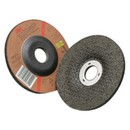
Guest Post by Glen Rosier
When visiting customers I am most commonly approached with the statement, “We are grinding ceramics”. The word “ceramic” is a very generalized statement covering a broad spectrum of materials. 20 years ago ceramics literally defined a material that was always alumina based with no other additives. Today, if someone were to say “Ceramic” it would be much like going to your favorite coffee shop and asking for a “Coffee”. The barista will then ask, “What type of coffee, whole/skim, grande/tall, iced/hot?”
Below, are the technical definitions for each material that could be referred to as “ceramic” and my interpretation of these terms as they apply to the industrial diamond grinding world.
Ceramic is a non-conducting material, often used as an insulator for electronics. The challenge in grinding ceramic is that, because it is non-conducting, the heat that is generated during the grinding process returns to the wheel. When the wheel absorbs this heat, particularly when using resin bonds, the heat can cause the resin to soften and glaze the wheel. Therefore, the grinding wheel must be dressed and sticked often to re-expose the crystals.
Alumina Based Ceramic is typically 99% pure alumina and is very easily ground with diamond wheels typically resin bond.
Silicon Nitride is much more chip-prone than alumina based ceramics and requires the use of a special micro-crystalline diamond in the grinding process.
Cermet contains high levels of metallic content such as titanium, nickel or both. Because of the metallic mix, Cermet is the most difficult of this class of materials to grind. The metals tend to load the diamond grinding wheel very quickly. This causes increased wheel wear, the need for frequent dressing, and substantially lower stock removal rates in the grinding equation.
Shop now for our line of Abrasive and Finishing products or call us at 303-422-3413
Ceramic vs. Cermet Materials in Cutting Tools
Ceramics used in cutting tool materials are based on aluminum oxide and silicon nitride. Ceramic tools can withstand higher cutting speeds than cemented carbide tools when machining hardened steels, cast irons and high-temperature alloys.
Whereas, Cermet cutting tool materials are based mostly on titanium carbonitride with nickel and/or cobalt binder. Cermets are characterized by high wear resistance due to their chemical and thermal stability. Cermets are able to hold a sharp edge at high cutting speeds and temperatures, which results in exceptional surface finish when machining most types of steels.
With these distinct qualities of “ceramic” materials in mind, you may be able to determine the grade of material you need to use in your grinding or tooling application. Recognizing these qualities and applying the right solution, are crucial to the success of using a ceramic based product or derivative in your operations.
This article brought to you by: Abrasive Technology


